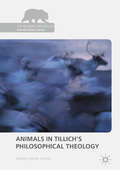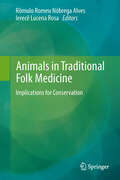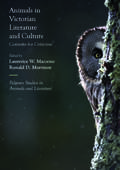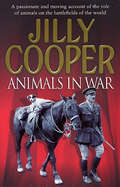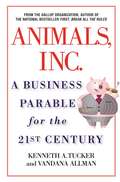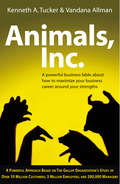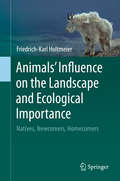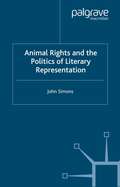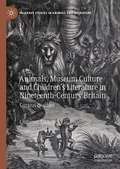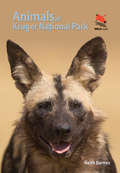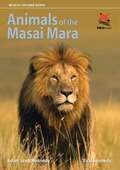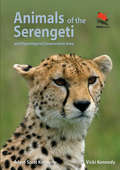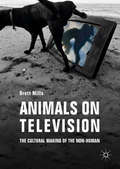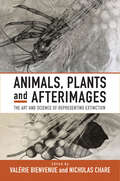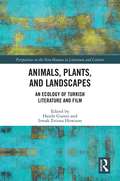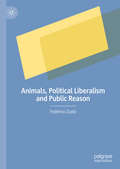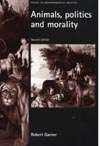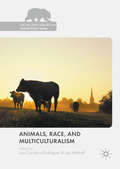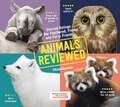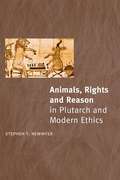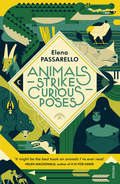- Table View
- List View
Animals in Tillich's Philosophical Theology (The Palgrave Macmillan Animal Ethics Series)
by Abbey-Anne SmithThis book explores how Paul Tillich’s systematic theology, focusing on the concepts of being and reason can benefit nonhuman animals, while also analysing how taking proper account of nonhuman animals can prove immensely beneficial. The author first explains the body of Tillich’s system, examining reason and revelation, life and the spirit, and history and the kingdom of God. The second section undertakes a critical analysis of Tillichian concepts and their adequacy in relation to nonhuman animals, addressing topics such as Tillich’s concept of ‘technical reason’ and the multidimensional unity of life. The author concludes by discussing the positive concepts in Tillich’s systematic theology with respect to nonhuman animals and creation, including the concept of universal salvation and Tillich’s interpretation of nonhuman animals and the Fall in Genesis.
Animals in Traditional Folk Medicine: Implications for Conservation
by Rômulo Romeu Nóbrega Alves and Ierecê Lucena RosaPeople have relied on medicinal products derived from natural sources for millennia, and animals have long been an important part of that repertoire; nearly all cultures, from ancient times to the present, have used animals as a source of medicine. Ingredients derived from wild animals are not only widely used in traditional remedies, but are also increasingly valued as raw materials in the preparation of modern medicines. Regrettably, the unsustainable use of plants and animals in traditional medicine is recognized as a threat to wildlife conservation, as a result of which discussions concerning the links between traditional medicine and biodiversity are becoming increasingly imperative, particularly in view of the fact that folk medicine is the primary source of health care for 80% of the world’s population. This book discusses the role of animals in traditional folk medicine and its meaning for wildlife conservation. We hope to further stimulate further discussions about the use of biodiversity and its implications for wildlife conservation strategies.
Animals in Victorian Literature and Culture: Contexts for Criticism (Palgrave Studies in Animals and Literature)
by Laurence W. Mazzeno Ronald D. MorrisonThis collection includes twelve provocative essays from a diverse group of international scholars, who utilize a range of interdisciplinary approaches to analyze “real” and “representational” animals that stand out as culturally significant to Victorian literature and culture. Essays focus on a wide range of canonical and non-canonical Victorian writers, including Charles Dickens, Anthony Trollope, Anna Sewell, Emily Bronte, James Thomson, Christina Rossetti, and Richard Marsh, and they focus on a diverse array of forms: fiction, poetry, journalism, and letters. These essays consider a wide range of cultural attitudes and literary treatments of animals in the Victorian Age, including the development of the animal protection movement, the importation of animals from the expanding Empire, the acclimatization of British animals in other countries, and the problems associated with increasing pet ownership. The collection also includes an Introduction co-written by the editors and Suggestions for Further Study, and will prove of interest to scholars and students across the multiple disciplines which comprise Animal Studies.
Animals In War: Valiant Horses, Courageous Dogs, And Other Unsung Animal Heroes (Lyons Press Series)
by Jilly Cooper ObePigeons carrying vital messages to and from the beleaguered city during the Siege of Paris; horses and mules struggling through miles of fetid mud to bring ammunition to the front in the Great War; dogs sniffing out mines for the British invasion force in the Second World War - countless brave animals have played their part in the long, cruel history of war. Some have won medals for gallantry - like G.I. Joe, the American pigeon who saved 100 British lives in Italy, and Rob, the black and white mongrel who made over twenty parachute jumps with the SAS. Too many others have died abandoned, in agony and alone, after serving their country with distinction. Jilly Cooper has here written a tribute to the role of animals in wartime. It is a tragic and horrifying story - yet it has its lighter moments too: a hilarious game of musical chairs played on camels during the Desert Campaign; and the budgie who remarked, when carried from a bombed-out East End tenement, 'This is my night out'. This is a vivid and unforgettable record of man's inhumanity to animals, but also an astonishing story of courage, intelligence, devotion and resilience.
Animals In War: Band 04 Blue/band 17 Diamond (Collins Big Cat Progress)
by Jillian Powell The Imperial War Museum Collins Big CatAnimals Inc.: A Business Parable for the 21st Century
by Vandana Allman Kenneth A. TuckerWith its previous bestsellers - First, Break All the Rules and Now, Discover Your Strengths - The Gallup Organization rewrote the book on great management. Now Gallup finally makes its classic, hilarious parable, ANIMALS, INC., available to the general public. A story that has proven effective and popular with Gallup clients for over thirty years, this tale introduces you to a group of unforgettable barnyard animals trying to run a successful business. Deciding that education is the key, the members of Animals, Inc. conduct employee surveys, evaluate competencies, and set up training classes. Filled with the excitement and hope that accompany any new project, they work hard to overcome their natural shortcomings. The workhorse tries to operate the computer, the shy sheep makes sales calls, the scarecrow attempts to lay eggs. What results will seem uncannily familiar to the human reader. As revelatory as Who Moved My Cheese? and as funny as Fish!, ANIMALS, INC. will have you laughing and learning at the same time. Recharge your thinking with invaluable practical insights. Get an edge in the business world you won?t discover anywhere else. And discover the key to effective management, reenergized morale, and super-heightened performance. Just listen to the animals.
Animals Inc: A Business Parable For The 21st Century
by Kenneth A Tucker Vandana AllmanAnimals,Inc is a time-tested business parable that has been tremendously popular with Gallup clients for more than 30 years: it's a favorite at corporate seminars and has even been released on video. It's the story of a group of animals who want to get rid of their shortcomings, or weaknesses, in order to make themselves more efficient. They decide to attend a school to learn how to improve themselves. But as the rabbit struggles to learn how to swim, as the pig attempts to climb trees, and as the other animals try to improve their weaknesses, they end up frustrated, unhappy, and quarrelling with each other. This simple but powerful parable explains a basic, very vital business lesson: that people should learn how to focus on their strengths in their workplace and offices rather than concentrating on their weaknesses.
Animals' Influence on the Landscape and Ecological Importance: Natives, Newcomers, Homecomers
by Friedrich-Karl HoltmeierIn its first English-language edition, this book introduces the many-faceted interactions of animal populations with their habitats. From soil fauna, ants and termites to small and large herbivores, burrowing mammals and birds, the author presents a comprehensive analysis of animals and ecosystems that is as broad and varied as all nature. Chapter 2 addresses the functional role of animals in landscape ecosystems, emphasizing fluxes of energy and matter within and between ecosystems, and the effects of animals on qualitative and structural habitat change. Discussion includes chapters on the role of animal population density and the impacts of native herbivores on vegetation and habitats from the tropics to the polar regions. Cyclic mass outbreaks of species such as the larch bud moth in Switzerland, the mountain pine beetle and the African red-billed weaver bird are described and analyzed. Other chapters discuss Zoochory – the dispersal of seeds by ants, mammals and birds – and the influence of burrowing animals on soil development and geomorphology. Consideration extends to the impact of feral domestic animals. Chapter 5 focuses on problems resulting from introduction of alien animals and from re-introduction of animal species to their original habitats, discusses the effects on ecosystems of burrowing, digging and trampling by animals. The author also addresses keystone species such as kangaroo rats, termites and beavers. Chapter 6 addresses the role of animals in landscape management and nature conservation, with chapters on the impact of newcomer species such as animals introduced into Australia, New Zealand and Europe, and the consequences of reintroduction of species to original habitat. It also discusses the carrying capacity of natural habit, public attitudes toward conversation and more. The final section ponders the effects of climate on interactions between animals and their habitats.
Animals, Literature and the Politics of Representation
by J. SimonsThis book addresses the question of animal rights in the context of literary criticism. Working from a committed position, it asks the question, 'What would literary studies look like if we took animal rights seriously?' It offers critical surveys of the main themes in the history of animal rights and some of the more important contemporary positions together with readings of a wide range of literary texts from classical antiquity to the present day.
Animals, Museum Culture and Children’s Literature in Nineteenth-Century Britain: Curious Beasties (Palgrave Studies in Animals and Literature)
by Laurence TalairachAnimals, Museum Culture and Children’s Literature in Nineteenth-Century Britain: Curious Beasties explores the relationship between the zoological and palaeontological specimens brought back from around the world in the long nineteenth century—be they alive, stuffed or fossilised—and the development of children’s literature at this time. Children’s literature emerged as dizzying numbers of new species flooded into Britain with scientific expeditions, from giraffes and hippopotami to kangaroos, wombats, platypuses or sloths. As the book argues, late Georgian, Victorian and Edwardian children’s writers took part in the urge for mass education and presented the world and its curious creatures to children, often borrowing from their museum culture and its objects to map out that world. This original exploration illuminates how children’s literature dealt with the new ordering of the world, offering a unique viewpoint on the construction of science in the long nineteenth century.
Animals of Kruger National Park (PDF)
by Keith BarnesSouth Africa's Kruger National Park is one of the largest and most diverse conservation areas in Africa, and a hugely popular visitor attraction. Animals of Kruger National Park is a compact and beautifully illustrated guide, and the essential companion for any safari to the region. With an eye-catching design, authoritative and accessible text and easy-to-use format, this detailed photographic guide provides information on identification, habitat, behaviour, biology and conservation for all the mammals, reptiles and frogs likely to be seen. Introductory sections provide background information on the park and its habitats, when to visit and where to go, and other practical considerations that will help to enhance your understanding, appreciation and enjoyment of the animals of this incredible region. The essential all-in-one Kruger safari companion, ideal for all visitors Unique and attractive layout, featuring 216 stunning colour photographs, 116 track (spoor) illustrations and two maps Covers 57 mammals, 17 reptiles and eight frogs Features the ‘Big 5’—elephants, leopards, lions, rhinoceroses and buffalos—as well as other iconic and charismatic animals Provides key information on identification, behaviour, biology and conservation
Animals of the Masai Mara (PDF)
by Adam Scott Kennedy Vicki KennedyOne of the greatest attractions of a trip to Kenya is the chance to see animals such as lions, cheetah, leopards, zebra, and giraffe up close and in their natural habitats. Animals of the Masai Mara is a lavish photographic guide that explores the charismatic wildlife most likely to be encountered by a safari visitor to the Masai Mara National Reserve in southwest Kenya. More than 140 stunning photographs showcase 65 mammals and 17 reptile species, including 6 snakes. Designed to be informative and locally accurate, rather than purely identification-based, this easy-to-use book pays particular attention to wildlife behavior and is written from the firsthand experiences of the authors and the knowledge of local safari guides. Numerous "Top Tips" throughout show readers how and where to locate specific species. The only field guide to focus solely on the wildlife of the Masai Mara National Reserve, Animals of the Masai Mara will be indispensable to visitors to this famous park and all nature enthusiasts with an interest in this area of the world. The only photographic guide specific to the animals of the Masai Mara National Reserve More than 140 remarkable photographs covering 65 mammals and 17 reptile species, including 6 snakes Accessible text explores animal behavior and other interesting facts A brief and informative introduction to the habitats of the Masai Mara
Animals of the Serengeti: And Ngorongoro Conservation Area (PDF)
by Adam Scott Kennedy Vicki KennedyContaining 146 stunning color photos, Animals of the Serengeti is a remarkable look at the mammals and reptiles most likely to be encountered in the world-famous Serengeti National Park and Ngorongoro Crater. With an eye-catching layout, accessible text, and easy-to-use format, this detailed photographic guide includes 89 species of mammal and reptile. Useful "Top Tips"—shared by local Tanzanian guides that work in the region—provide visitors with insights into behavioral habits and how to locate specific animals. Filled with vivid anecdotes, Animals of the Serengeti will enable any safari traveler to identify the area's wildlife with ease.Covers the 89 species likely to be encountered in Tanzania’s Serengeti National Park and Ngorongoro Conservation Area Features male and female variationsAccessible text aimed at safari visitors of all levels
Animals on Television: The Cultural Making of the Non-Human
by Brett MillsThis book is the first in-depth study of the representation of animals on television. It explores the variety of ways animals are represented in audio-visual media, including wildlife documentaries and children’s animated series, and the consequences these representations have for those species. Brett Mills discusses key ideas and approaches essential for thinking about animals drawing on relevant debates in philosophy, politics, gender studies, humanism and posthumanism, and ethics. The chapters examine different animal representations, focusing on zoos, pets, wildlife and meat. They present case studies, including discussions of Peppa Pig, The Hunt and The Dog Whisperer. This book will be of interest to readers exploring media studies, contemporary television, animal studies, and debates about representation.
Animals, Plants and Afterimages: The Art and Science of Representing Extinction
by Valérie Bienvenue Nicholas ChareThe sixth mass extinction or Anthropocene extinction is one of the most pervasive issues of our time. Animals, Plants and Afterimages brings together leading scholars in the humanities and life sciences to explore how extinct species are represented in art and visual culture, with a special emphasis on museums. Engaging with celebrated cases of vanished species such as the quagga and the thylacine as well as less well-known examples of animals and plants, these essays explore how representations of recent and ancient extinctions help advance scientific understanding and speak to contemporary ecological and environmental concerns.
Animals, Plants and Afterimages: The Art and Science of Representing Extinction
by Nicholas Chare Valérie BienvenueThe sixth mass extinction or Anthropocene extinction is one of the most pervasive issues of our time. Animals, Plants and Afterimages brings together leading scholars in the humanities and life sciences to explore how extinct species are represented in art and visual culture, with a special emphasis on museums. Engaging with celebrated cases of vanished species such as the quagga and the thylacine as well as less well-known examples of animals and plants, these essays explore how representations of recent and ancient extinctions help advance scientific understanding and speak to contemporary ecological and environmental concerns.
Animals, Plants, and Landscapes: An Ecology of Turkish Literature and Film (Perspectives on the Non-Human in Literature and Culture)
by Hande Gurses Irmak Ertuna HowisonThe landscape of Turkey, with its trees and animals inspires narratives of survival, struggle and escape. Animals, Plants, and Landscapes: An Ecology of Turkish Literature and Film, will be the first major study to offer fresh theoretical insight into this landscape, by offering a collection of analyses of key texts of Turkish literature and cinema. Through discussion of both classical and contemporary works, this volume, paves the way for the formation of a ecocritical canon in Turkish literature and the rise of certain themes that are unique to Turkish experience. Snakes, fishermen and fish who catch men, porcupines contemplating on human agency, dogs exiled on an island and men who put dogs to fights, goat herders and windy steppes of Anatolia are all agents in a territory that constantly shifts. The essays included in this volume demonstrate the ways in which the crystallized relations between human and non-human form, break, and transform.
Animals, Plants, and Landscapes: An Ecology of Turkish Literature and Film (Perspectives on the Non-Human in Literature and Culture)
by Hande Gurses Irmak Ertuna HowisonThe landscape of Turkey, with its trees and animals inspires narratives of survival, struggle and escape. Animals, Plants, and Landscapes: An Ecology of Turkish Literature and Film, will be the first major study to offer fresh theoretical insight into this landscape, by offering a collection of analyses of key texts of Turkish literature and cinema. Through discussion of both classical and contemporary works, this volume, paves the way for the formation of a ecocritical canon in Turkish literature and the rise of certain themes that are unique to Turkish experience. Snakes, fishermen and fish who catch men, porcupines contemplating on human agency, dogs exiled on an island and men who put dogs to fights, goat herders and windy steppes of Anatolia are all agents in a territory that constantly shifts. The essays included in this volume demonstrate the ways in which the crystallized relations between human and non-human form, break, and transform.
Animals, Political Liberalism and Public Reason
by Federico ZuoloThis book explores the problem of disagreement concerning the treatment of animals in a liberal society. Current laws include an unprecedented concern for animal welfare, yet disagreement remains pervasive. This issue has so far been neglected both in political philosophy and animal ethics. Although starting from disagreement has been the hallmark of many politically liberal theories, none have been devoted to the treatment of animals, and conversely, most theories in animal ethics do not take the disagreement on this issue seriously. Bridging this divide with a change of perspective, Zuolo argues that we should begin from the disagreement on the moral status of animals and the treatment we owe them. Reconstructing the epistemic nature of disagreement about animals, Zuolo proposes a novel form of public justification to find principles acceptable to all. By setting out a unified framework which honours the liberal principles of respect for diversity, a robust liberal political theory capable of dealing with diverse forms of disagreement, and even some forms of radical dissent, is achieved.
Animals, politics and morality: Second edition (Issues in Environmental Politics)
by Robert GarnerHow do we treat animals? How ought we to treat them? These are the two central questions tackled in the extensively re-written and up dated second edition of this well-regarded and much-cited text. It remains the only book which combines in a single volume, not only a concise and accessible account of the on going debate about animals in moral and legal philosophy, but also a detailed analysis of how this debate is central to an understanding of the ways in which animals are treated.In the last decade in Britain, we have witnessed major campaigns and public controversy over the export of live animals, and the use of animals in research. Major campaigns have been mounted against companies such as Shamrock and Huntingdon Life Sciences. The impact of genetic engineering on the welfare of animals has also emerged as an important area of concern. In addition, the controversy over hunting has become even more pronounced, with the launch of the pro-hunting Countryside Alliance.
Animals, Race, and Multiculturalism (The Palgrave Macmillan Animal Ethics Series)
by Luís Cordeiro-Rodrigues Les MitchellThis book focuses on multiculturalism, racism and the interests of nonhuman animals. Each are, in their own right, rapidly growing and controversial fields of enquiry, but how do multiculturalism and racism intersect with the debate concerning animals and their interests? This a deceptively simple question but on that is becoming ever more pressing as we examine our societal practices in a pluralistic world. Collating the work of a diverse group of academics from across the world, the book includes writing on a wide range of subjects and addressing contemporary issues in this critical arena. Subjects covered include multiculturalism, group rights and the limits of tolerance; ethnocentrism and animals; racism and discrimination and non-Western alternatives to animal rights and welfare. The book will be of interest to researchers, lecturers and advanced students as well as range of social justice organisations, government institutions, animal activist organisations and environmental groups.
Animals Reviewed: Starred Ratings of Our Feathered, Finned, and Furry Friends
by Association of Zoos and AquariumsZookeepers hilariously review the animals in their keep—from the anxious aardvark to the zealous zebra shark and every animal in between.
Animals, Rights and Reason in Plutarch and Modern Ethics
by Stephen T. NewmyerThis groundbreaking volume explores Plutarch's unique survival in the argument that animals are rational and sentient, and that we, as humans, must take notice of their interests. Exploring Plutarch's three animal-related treatises, as well as passages from his ethical treatises, Stephen Newmyer examines arguments that, strikingly, foreshadow those found in the works of such prominent animal rights philosophers as Peter Singer and Tom Regan. Unique in viewing Plutarch’s opinions not only in the context of ancient philosophical and ethical through, but also in its place in the history of animal rights speculation, Animals Rights and Reasons points out how remarkably Plutarch differs from such anti-animal thinkers as the Stoics. Classicists, philosophers, animal-welfare students and interested readers will all find this book an invaluable and informative addition to their reading.
Animals, Rights and Reason in Plutarch and Modern Ethics
by Stephen T. NewmyerThis groundbreaking volume explores Plutarch's unique survival in the argument that animals are rational and sentient, and that we, as humans, must take notice of their interests. Exploring Plutarch's three animal-related treatises, as well as passages from his ethical treatises, Stephen Newmyer examines arguments that, strikingly, foreshadow those found in the works of such prominent animal rights philosophers as Peter Singer and Tom Regan. Unique in viewing Plutarch’s opinions not only in the context of ancient philosophical and ethical through, but also in its place in the history of animal rights speculation, Animals Rights and Reasons points out how remarkably Plutarch differs from such anti-animal thinkers as the Stoics. Classicists, philosophers, animal-welfare students and interested readers will all find this book an invaluable and informative addition to their reading.
Animals Strike Curious Poses
by Elena PassarelloBeginning with Yuka, a 39,000-year-old mummified woolly mammoth recently found in the Siberian permafrost, each of the sixteen essays in Animals Strike Curious Poses investigates a different famous animal named and immortalised by humans. Here are the starling that inspired Mozart with its song, Darwin’s tortoise Harriet, and in an extraordinary essay, Jumbo the elephant (and how they tried to electrocute him). Modelled loosely on a medieval bestiary, these witty , playful, provocative essays traverse history, myth, science and more, introducing a stunning new writer to British readers.
